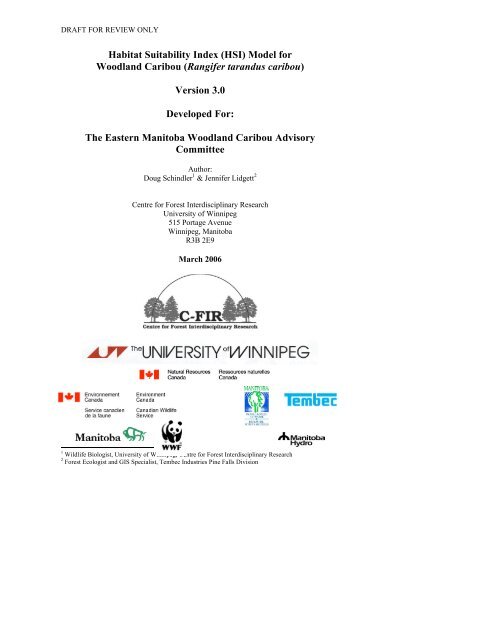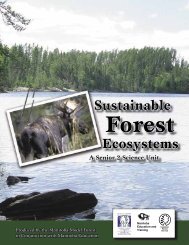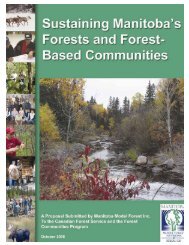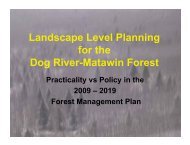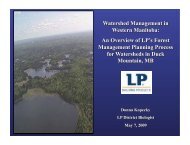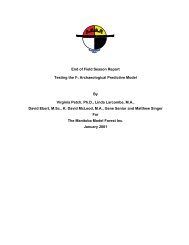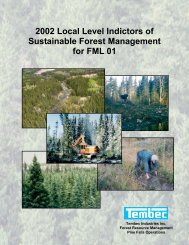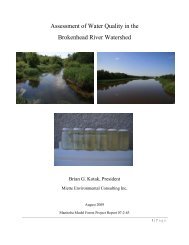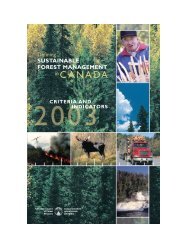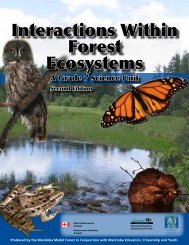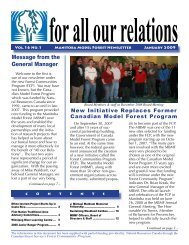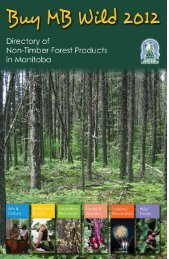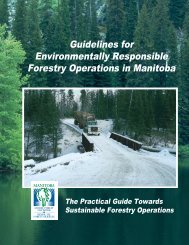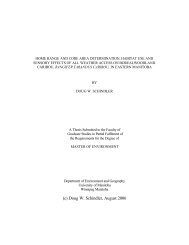Habitat Suitability Index - Manitoba Model Forest Inc.
Habitat Suitability Index - Manitoba Model Forest Inc.
Habitat Suitability Index - Manitoba Model Forest Inc.
Create successful ePaper yourself
Turn your PDF publications into a flip-book with our unique Google optimized e-Paper software.
Caribou age class selectedo SouthernYounger forest not really selected forHighest use in 60 year old forest Becker stated that age was quite variable. If examine age should be done in terms ofspecieso HistoricEvidence of disturbance (due to cutting or burn?)- greater use ofyounger areas can be seen Keenan stated that age of disturbance origin should be determinedo Northern Select ages between 40 and 90Younger areas were not used much Suspect data for summer levels were skewed because of a lack of data for the parkCaribou moisture class selected (productive site)o SouthernGreatest use in arid areaso Historic (southern)Trend very similar Moisture class did not seem like a good variable because it did not match with subtypeused (muskeg)o NorthernSimilar to southernCaribou landform class (productive site) Hagglund wanted to choose attributes for both productive and non-productive sites Schindler and Lidgett did not think it was necessary as it was not done the last timeo SouthernThere was little use of dense productive jack pine (4- sandy area)o Historic (southern)o NorthernNot big difference from the south High value number 2 Keenan thought landform wise that 1 and 2 were the same7
Assigning values to winter variables in terms of food Look at both north and south because only want one model Hagglund was not sure about doing one model that included the north and south. Hewondered if the north should be left out because of the lack of data from the park Crichton cautions that should not accept something that is extremely weak for onearea in comparison to the other Crichton also said to keep in mind that the old method was working and should not bealtered drasticallyVariable valuesExcellent = 1.0 Good = 0.75 OK = 0.5 Poor = 0.25 No Value = 0.1S.I. V1- Sub-typeSub-type Value1 n/a2 n/a4 0.86 110 011 013 0.314 0.515 0.216 0.117 n/a20 0.0121 0.122 n/a30 0.131 0.132 n/a36 n/a37 n/a41, 42, 43 n/a44 0.145 n/a46 0.148, 49 n/a50-56 0.0157 n/a58 0.0160 0.0161 0.0162 n/a70 0.0171 0.0172 n/a76 and 77 n/a80’s 0.0190's 0.01701 0.8702 0.8703 and 704 n/a711 0.8712 0.8713 0.1720’s 0.1730's 0.01801-820 n/a831 0.8832 0.5835 0.01Rest 800's n/a848 0.4900's n/a Schindler thought 04 and 06 were similar but 04 value should be slightly lowerbecause the southern value was lower Leavesley did not want to give 13 a good rating because she did not think it would bean area used greatly however the data showed otherwise – question, if use shown wasbecause of cover or an issue of adjacency 14 showed greater use than 13 (because of the pine) - value should be good10
For 15 most of the use is seen in the north because of the balsam combination For 16, there is more on the landscape but it is not used as much as 15 17 is n/a for this study however the caribou are tied to cedar in the far north - it haspotential in the Interlake area 20 is in the landscape but they are not choosing it There is not a lot of 21 available and they are not keying in on it 22 is Balsam and cedar 30 is not widely used 44 is very similar to 31 46 has a lot of aspen. The caribou food is only found in the buffer areas. They arenot making use of the sub-type from a food perspective 50 is not being used at all 51 is low because of hardwood component 54 shows some use but it may be due to overlap with buffer 57 is a cedar sub-type Surprised that 60 is not being used as much. It has a Balsam Fir component but it isalso ½ hardwood 76 and 77 are cedar/hardwood sub-types There is a little bit of use for 90’s sub-types but suspect it is owed to relationship 701 is a Black Spruce Treed Muskeg area and its use is very high, but, not as high assub-type 06. Its value should be raised from the last model 702, the Tamarack/Larch. It seems to have more importance in the North than South.Possibly because there is not as much available in the south. They are using it twiceas much as it is available in all areas 703 and 704 are Eastern Cedar Taiga 711 was only 0.4 in the last model. They are keying in on it less than the BlackSpruce however it is a good area. It needs to be bumped up. As good as 701/702. There is not much in 712 but they key in on it when they find it. It does not appear tobe a factor of buffer There is not a lot of 713 but there is rock and therefore lichen11
There is some valueo Discussion on sedgeso Schindler suggest need look at summer food as well as some of the areasare better in summer than winter 831 in the last model was 0.5 but it is being used a great deal in the north. They wereusing it significantly in terms of what was available. The value should therefore behigher.o Schindler suggested that these sites should be examined come winter – arethey using or are they stuck There was not a lot of 832 but they were using it (especially up north). In terms ofavailability they were not using it a lot (summer) Not see them in the tall grass (835). There is no indication they use them 848 are used as much as they are available in the south but the areas are used as travelcorridors. The value should be as good as sub-type 13. Some believed a little higherbecause of arboreal lichen and possible mineral licks 900 sub-type is used just for travelS.I. V2- Age ClassAge Class Value10 0.1020 0.2030 0.3040 0.5050 0.4560 1.0070 1.0080 1.0090 1.00100 0.80120 0.75 Looking at the old model it was thought that class 4 and 5 should be lower thanoriginally rate (over-mature) Highest values were thought to occur at 60 years old (appears to be threshold) It must be remembered that Owl Lake range is a burn area and they are using what isavailable. Also caution the burned areas because interpreters say it is bedrock when itis actually treed rock There are two different scales in terms of north and south (north peaks never getabove 20%)12
60-90 are a patchwork- they are not really choosing it, it is just there as such pick midpoints then reach plateau 30 year old class has greater lichen availability but there may be other limiting factorsas to why they are not taking advantage of those areasNote:Age class is the most variable-least confidenceThere was disagreement about linear relation regarding winter food and agevariableS.I. V3- Height classHeight Class Value1 0.102 0.103 0.104 0.105 0.206 0.207 0.208 0.209 0.3010 0.5011 0.6012 1.0013 1.0014 1.0015 1.0016 1.0017 1.0018 0.7519 0.7520 0.7521 0.50 Breaking point is 13 (use is greater than availability) Has an almost normal distribution however the greatest use is in the taller range untilit gets overly tall Preference begins at class 12 with the highest use and proportionately greatest is inclass 14 and 15 Data should reflect breaking point at 17. Value should drop after that The use however is still high up until height class 20. There was disagreement regarding shape of curves for age class and height class.Whaley thought they should both be “bell curves” Collins pointed out that the decisions should be based on what caribou (data) weresaying not on what we thought Swanson stated we should defer to height It was decided that height and sub-type were importantNote: There is a non-linear relation with height class in earlyclasses13
1.0 V4V5 = 70 0.80Discussion regarding which equation to use (geometric, arithmetic, weighted) Appeared to be a problem using arithmetic mean. Those with poor habitat seemed toindicate really good habitat Should compare the arithmetic mean to the others using regression to see how far offthe points are. This would give a better understanding of how the model was working Geometric equation was determined to be the best choice because ofo Documentation regarding geometric method in HEP procedureso Weighted and arithmetic equations do not identify the burn area like thegeometrico The result of weighted and arithmetic means is high. The geometric meanbrings this down so that not every stand will work out to good habitato The geometric mean worked last time was it necessary to change itNote: should look at use in relation to new H.S.I. values Examine using values 0.01 and 0.1 to see if that makes a difference Stand #19 variable 5 value was changed from 0.01 to 0.1o AM = 0.29o GM = 0.12o Difference not substantial Questions regarding behaviour of caribou and the reflection on the modelo Is it possible that the lack of spread into available habitat is due to aninsufficient population sizeo Issue of fidelity and social habit– they keep going back to the same areayear after year and it is expected that they will stay together until they arepushed outNote: recommended look at 831’s on groundWould make a good project approach for university- project for students Use of variable is an indirect way of assessing lichen productive areas Question about using vegetation type16
o Vegetation type is just interpretation of the FRI Miller suggested it would be a good idea to map October and March to get betweenseason datao Not possible because it is different for each animal due to time threshold There is value in going back to look at the 1980’s unpublished reports for cariboudata on the east side. Could help because of discussion about crown closure. The usecratering data, verify what values we achieved. Part of validation process.Assigning values to summer variables in terms of food and cover Less focus on food because they are not as restricted as they are in winter but foodimportant to get through the winter Difference between summer and winter rangeo Summer use higher country, lake areao Winter use lowland bogs Summer browse is lichen rock ridges, stripping leaves (birch, pincherry), sedges Nothing seems to stick out as key South shows better data because too much data missing from north range (because ofpark) Islands are not used because cannot get on them and they are site specific Data for water seemed off suggest buffering water- where intersect with more suitablehabitat, bump it up Cover important in summer- according to literature they are keying in on cover Stick to data from south because lack of data for north When applying values stick to broader numbersVariable valuesExcellent = 1.0 Good = 0.75 Okay = 0.5 Poor = 0.1S.I. V1- Sub-type Crichton suggested that 13 should be the same as 14o Leavesly questioned this because did not feel the data supported thiso Schindler pointed out that the variable was also being rated based on covernot just food The southern range is keying in on number 11 but this was not seen in historic Tamarack stands are used more than availableo Denser tamarack is of higher valueo Bump tamarack17
40’s and 50’s (hardwood and mixed-wood) offer more in terms of cover and food insummer than in winter therefore bump 54-56 Beaver floods are used less Crichton questions why they would use 701o Escape from predator 701 should be treated differently than 702 but still high Swanson stated that treed rock should be 0.8o Lidgett and Schindler stated it should be lower (treed rock)o Cross noted there was some use but mostly in terms of covero 711 and 712 should be 0.5 721 rated low (willows) Everything up to 848 should be low 838-848 rated lowo Disagreement because 831 use is great in north (predator avoidance)o 832 used a lot in north – not as much use in south because not as muchavailableS.I. V2- Crown Class Class 5, 6, 7 high values- need to bump up values for 6, 7 Class 3 and 4 should stay the same food value still high (especially in north) Class 9 is much lower in the north- food drops and use drops Animals in north out of range in summer, put more weight on data from southo Examining south- class 3 and 4 should be brought down, 5 stays the same,6-9 raisedS.I. V3- Height Decided that Class 12 in winter should be less and Class 18 should be raised More of a drop off in higher areas for summer Start with 16 at 0.5, 18 at 0.5, 19 at 0.25, 21 at 0.25, 22 at 0.1 summer and winterS.I. V4- Age Large difference between north and south use and availabilityo Confidence using south data for H.S.I.o No confidence for north- requires testing, caution, retooling18
Lidgett stated that need age for wood supply Swanson noted they are keying in on certain age groups Age is tough for summer habitat Age 50 use increases, drops at 30 and at 90 Swanson suggested 110 should be no/low valueS.I. V5- Moisture Class Keensn stated that logically arid should be skinny soils- 2 should be slightly moreproductive Leavesly stated the data was no different than winter Lidgett agreed Cross suggested brining up number 2 Leavesley disagreed Schindler noted that sub-type and age are critical, if the wet sites are kept low thenblack spruce habitat is lost Disagreement about the values for class 3 and 4o Should raise class 4 and drop class 3 because not really using it when lookat sub-typeso Class 3 and 4 should be bumped up so as not to lose important blackspruce Keep class 3 and 4 the sameNote: concern about value of black spruce in terms of summer cover19
SUITABILITY INDEX VARIABLES AND ASSOCIATED VALUES (0.0 – 1.0)Subtype SI_1_W SI_1_S1 0.01 0.012 0.01 0.014 0.8 0.85 0.01 0.016 1 18 0.01 0.019 0.01 0.0110 0.01 0.0111 0.01 0.113 0.3 0.7514 0.5 0.7515 0.2 0.216 0.1 0.117 0.01 0.0120 0.01 0.0121 0.1 0.122 0.01 0.0130 0.1 0.5Age10C SI_2_W SI_2_S1 0.1 0.110 0.1 0.120 0.2 0.230 0.3 0.240 0.5 0.850 0.75 160 1 170 1 180 1 190 1 0.8100 0.8 0.8110 0.8 0.5120 0.75 0.1130 0.75 0.1140 0.75 0.120
Height SI_3_W SI_3_S0 0.1 0.11 0.1 0.12 0.1 0.13 0.1 0.14 0.1 0.15 0.2 0.26 0.2 0.27 0.2 0.28 0.2 0.29 0.3 0.310 0.5 0.511 0.6 0.612 0.75 113 1 114 1 115 1 116 1 0.517 1 0.5Moist Class SI_4_W SI_4_S1 1 0.92 1 13 0.2 0.24 0.4 0.4Crown SI_5_W SI_5_S0 0.01 0.011 0.3 0.32 0.5 0.53 1 14 1 15 1 16 0.8 17 0.8 18 0.5 0.59 0.3 0.3Jennifer Lidgett 06-3-26 2:25 PMDeleted: _V121
Final Version 3 <strong>Habitat</strong> Unit CalculationsBased on the above documentation the following HSI algorithm was developed.Productive StandsHSI Winter = ([Si_1_w] * [Si_2_w] * [Si_3_w] * [Si_4_w] * [Si_5_w]) ^ 0.20HSI Summer = ([Si_1_s] * [Si_2_s] * [Si_3_s] * [Si_4_s] * [Si_5_s]) ^ 0.20Jennifer Lidgett 06-3-26 2:25 PMDeleted: _v1Non Productive StandHSI Winter = [Si_1_w]HSI Summer = [Si_1_s]<strong>Habitat</strong> Unit CalculationsHU Winter = [HSI Winter] * [Hectares]HU Summer = [HSI Summer] * [Hectares]22
Validation ProcessFollowing the Delphi workshop, the authors developed the HSI logarithm for thecurrent FRI database in Esri ArcView. An interactive analysis was conducted bycomparing model outputs and manually generated stand values. Validation of variousFRI ploygons HSI values was conducted using the result of the habitat use versusavailability analysis conducted by Schindler (2005). This was done using the model forboth the Owl Lake Range (FMU 31) and the Atikaki/Berens Range (FMU 31 and 35).The assessment of habitat use based on the version 3 HSI model illustrateed that there is ahigh degree of selectivity of stands that have predicted high HSI values. In the Owl Lakearea, caribou were found to use high HSI stands 62% of the time, compared to anavailability rate of 30%. In the Atikaki/Berens Range, caribou used high value stands ata rate of 77% relative to a 44% availability rate.Further validation processes could include assessment of current and updatedwoodland caribou relocation data, and comparisons of habitat selection. These data maybe available on an annual basis. Annual review of these data is recommended to assessthe validity of model outputs and potential to adjust one or more of the modelcomponents.The Version 3 HSI model as documented is assumed to provide an estimate ofhabitat quantity and quality for woodland caribou. The minimum application area forevaluation of habitat is one township or 36 square miles.23
Northern RangeAPPENDIX 1 USE AVAILABILITY DATASubtype Breakdown1
Subtype BreakdownSouthern Range2
Subtype BreakdownSouthern Historic Range (based on historical range of Owl Lake caribou)3
APPENDIX 2 – SUBTYPE DESCRIPTIONSProductive DescriptionSubtypes4 jp 71-100%6 jp 40-70%-spr13 bs 71-100%14 bs 40-70%-jp15 bs 40-70% - bf, ws16 bs 40-70% - tl21 bf 40-70% - spr30 tl 71-100%31 tl 40-70% - spr44 jp >50% - mixedwood46 jp


